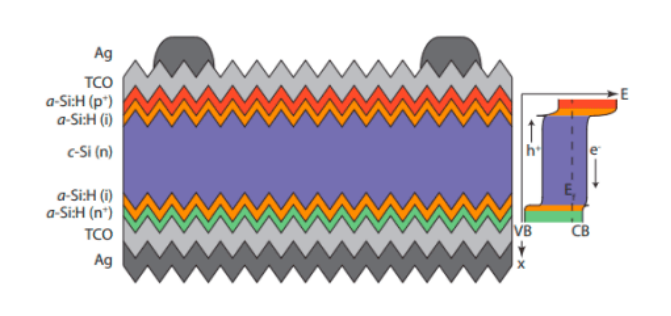
量子效率测试仪
PL/EL一体机
Sinton硅片少子寿命测试仪
Sinton硅块少子寿命测试仪
绒面反射率测试仪
3D共聚焦显微镜
清洗制绒工作站
在线四探针方阻测试仪
全自动扫描四探针方阻测试仪
在线薄膜厚度测试仪
晶化率测试仪
Horiba显微共焦拉曼光谱仪
傅里叶红外光谱仪
霍尔效应测试仪
分光光度计
全光谱椭偏仪
Horiba椭圆偏振光谱仪
TLM接触电阻率测试仪
超景深显微镜
网版智能影像测量仪
全自动影像测量仪
卧式拉力机
电池片稳态光衰老化试验箱
电池片紫外老化试验箱
电池片拉脱力综合测试仪
外观检验台
湿漏电测试系统
组件实验室EL测试仪
紫外老化试验箱
稳态光衰老化试验箱
电流连续性监测系统
PID测试系统
旁路二极管测试系统
LeTID测试系统
反向电流过载系统
脉冲电压测试系统
绝缘耐压测试仪
接地连续性测试仪
绝缘耐压接地测试仪
湿热环境试验箱
湿冻环境试验箱
热循环试验箱
动态机械载荷测试机
静态机械载荷测试机
冰雹冲击试验机
引出端强度试验机
霰弹冲击试验机
抗划伤(切割)测试机
剥离试验机
万能材料试验机(单臂)
万能材料试验机(双臂)
光伏玻璃透过率测试仪
醋酸测试试验箱
交联度测试系统
二极管接线盒综合测试仪
落球冲击试验机
半自动四探针
全自动探针式台阶仪
多通道太阳能MPPT系统
Horiba稳瞬态荧光光谱仪
钙钛矿P1激光划线测试仪
钙钛矿在线膜厚测试仪
钙钛矿工艺检测工作站
手持式IV测试仪
便携式EL测试仪
手持热成像测试仪
户外组件IV测试仪
户外组件多通道测试系统
光伏逆变器电能质量测试仪
无人机EL检测仪
电池片PID测试仪|电势诱导衰减效应详解
日期:2024-04-22浏览量:10
随着可再生能源的发展,太阳能发电系统作为清洁能源的重要形式之一,受到了广泛关注。然而在实际运行中常常会受到PID效应(Potential Induced Degradation电势诱导衰减)的影响,导致功率衰减,效率下降,从而影响整个太阳能发电系统的性能。本文将围绕不同类型的PID机制而展开,并介绍电池片PID测试仪。

PID主要类型

P型电池的PID效应特点
P型双面双玻电池一般在正面发生PID-s,背面PID-p,可能发生PID-c衰减。
正面:Na+离子从玻璃出析出后由于P型电池上表面为P掺杂,带负电,因此Nat离子有趋势进一步向电池片内部迁移,易出现PID-s,相反由于N型电池的上表面为B掺杂,带正电,阻止了Na+离子的向内移动,因此N型电池正面不易形成PID-s;
背面:相较于P型单玻而言,背面由铝背场改为铝线,外电场驱使正电荷更易破坏氧化铝的场钝化作用因此更易出现 PID-p:此外,P型双玻的背面由于采用了 Ag/Al浆电极,相较正面对水汽、酸更敏感。

P型双面太阳能电池结构图
N型电池TOPCon的PID效应特点

TOPCon电池PID-s原理图
正面易发生PID-p,背面PID效应不明显。TOPCon电池的正面结构与P型双玻的背面结构类似,因此更易发生PID-p,同时正面采用Ag/AI浆电极对水汽和酸更敏感。TOPCon电池的背面与P型双玻的正面类似,由于钝化效果较好,不易产生PID-p。

TOPCon电池PID-c参数监控图
N型HJT电池的PID效应特点
双面易出现PID-c,HJT 是双面对称结构,是在N晶硅片的上下镀本征非晶硅,再镀非晶硅钝化层、ITO掺杂层做发电薄膜,从机理上没有PID-p的现象,但由于ITO为参杂的氧化铟锡导电膜材料,易产生因沉淀而出现PID-c,此外,HJT电池的非晶硅层和ITO对紫外光、水汽更敏感,并且由于其表面结构与晶硅电池片差别较大,与常规封装胶膜粘结力较弱。

HJT电池结构图
从上述分析中可知,无论n型或是p型组件产生PID效应的诱因都是一致的,仅在不同位面的PID类型有所区分,n型电池的电场相对p型电池更高,电荷集中对P-N结内建电场的影响更加明显。n型电池载流子表面负荷主要集中于电池正面,与p型电池P-N结方向相反,故PID衰减主要集中于电池正面,而正面是组件功率输出的主力,这就导致TOPCon电池的PID效应相比PERC电池更加明显。
电池片PID测试仪

介绍:
Freiberg instruments与Fraunhofer csp联合开发电池片PID测试仪,通过对电池片施加温度、光照和高电压,并在两个方向上极化后测量光照下的IV曲线,以确定PID敏感度,检验出上述PID机制。
满足标准:
根据IS09001制造,符合CE标准,IEC 62804-TS标准
特点:
•易于使用的台式设备,且无需环境箱
•测试时长:4小时;电压:±1.5kV
•PERC、AL-BSF、PERC+、双面PERC、PERT、PERL 和IBC电池的研究、生产和质量控制
•可测量参数:分流电阻、功率损失、电导率、泄漏电流、湿度和温度
•基于IP的系统,可以世界任何地方进行远程操作和技术支持
PID效应的出现可能太阳能发电系统的发电量快速降低(幅度甚至可达到50%),严重影响了系统的寿命和电站的正常收益,阻碍了光伏发电系统的快速应用,因此研究PID效应的产生和防治对光伏发电系统的发展具有十分重要的意义。电池片PID测试仪,快速检测决定电池片性能的重要参数,提前预测PID的影响,监测PID衰减和恢复过程。




































































